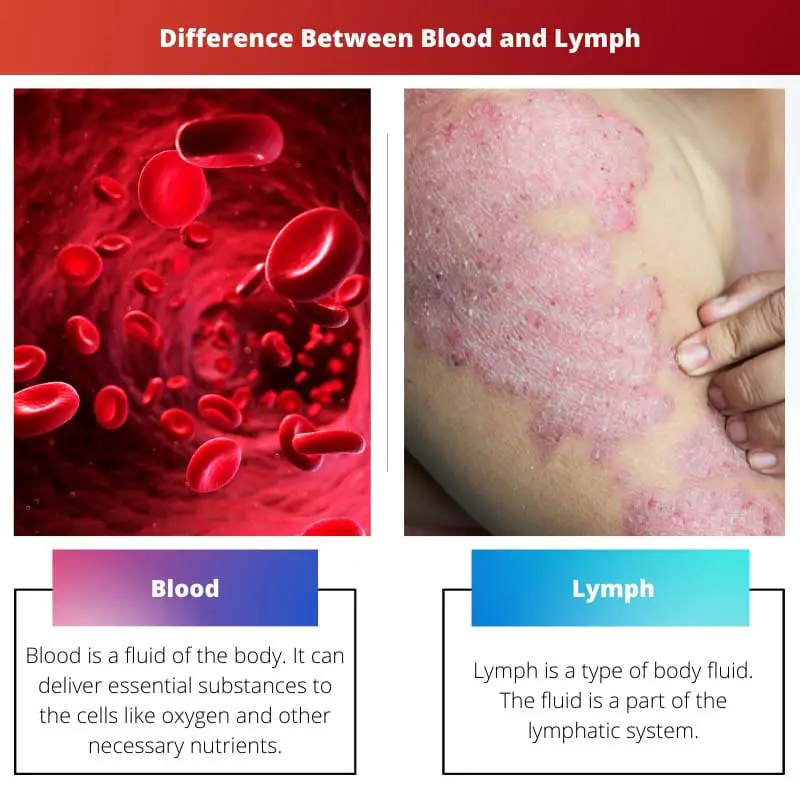Body fluids are the functional compartments of the body which are arranged in a dynamic yet orderly fashion. Body fluids have a specific role to play in the body.
The two most important and common body fluids are blood and lymph in the human body. Both fluids are part of different systems in the body.
Key Takeaways
- Blood is a red, oxygen-carrying fluid circulating throughout the body. At the same time, lymph is a clear or yellowish fluid that helps maintain the body’s fluid balance and supports the immune system.
- Blood contains red and white blood cells, platelets, and plasma, while lymph contains lymphocytes, proteins, and fewer red blood cells.
- The circulatory system transports blood, while the lymphatic system carries lymph fluid.
Blood vs Lymph
Blood is a red, oxygen-rich fluid that is pumped by the heart and circulates throughout the body to deliver oxygen and nutrients to cells. Lymph is a clear, colorless fluid that flows through the lymphatic system and carries immune cells that helps remove waste and toxins from the body.

Blood can deliver essential substances to the cells, like oxygen and other necessary nutrients. Blood can also transport waste products from one cell to another, metabolic.
The average density of blood is around 1060 kg per meter cube. In an adult human, the blood volume is about 5 litres or 1.3 gallons. The pH of normal blood is around 7.35 to 7.45.
While Lymph is formed from interstitial fluid, lymph is also produced in the human digestive system. That is known as chyle and is rich in fats, triglycerides. The appearance of the substance is milky white because of the high lipid content.
Comparison Table
| Parameters of Comparison | Blood | Lymph |
|---|---|---|
| Word derivation | Blood is derived from the Latin word “haema” | Lymph is derived from the Latin word “lympha” |
| Colour | Blood is reddish colored fluid | Lymph is a colorless fluid |
| Fundamental element | Blood is a part of the circulatory system | Lymph is a part of the lymphatic system |
| Function | The main function of blood is to help in the circulation of nutrients, oxygen, hormones, carbon dioxide, and removal of waste and other toxins | The main function of lymph is to help in body defense and take an active part in the immune system |
| Flow speed | Blood travels faster in the blood vessels | Lymph travels comparatively slower than blood |
What is Blood?
Blood is a fluid in the body. It can deliver essential substances, like oxygen and other necessary nutrients, to the cells. Blood can also transport waste products from one cell to another, metabolic.
It contains blood cells that are suspended in the blood plasma. Blood plasma is constituted of water and partially of blood fluid.
The blood cells that are found in the body fluid are Red Blood Cells (RBCs), White Blood Cells (WBCs), and Blood Platelets. They are also known as erythrocytes, leucocytes and thrombocytes, respectively.
The blood contains haemoglobin, which is an iron-containing protein. The importance of this protein is that it facilitates the transport of oxygen by binding the respiratory gas.
It increases the solubility in the blood. The term ‘blood’ derivation is from the Latin word “haema”.
Blood also has immunological functions are that it helps in the circulation of white blood cells and can detect any foreign material by the antibodies.
Blood also helps in coagulation, which is a response to any blood vessel which gets broken, and as a result, blood forms a semi-solid gel to stop bleeding from that site of injury. Blood also helps in temperature regulation and other hydraulic functions.
The average density of blood is around 1060 kg per meter cube, which is close to the density of pure water. In an adult human, the blood volume is about 5 litres or 1.3 gallons.
The pH of normal blood is around 7.35 to 7.45. The oxygen saturation in oxygenated blood is about 98 to 99%, while in deoxygenated blood is about 75%.

What is Lymph?
Lymph is a type of body fluid. The fluid is a part of the lymphatic system. Several lymph vessels or channels and lymph nodes constitute the lymphatic system in the body.
The system functions as a venous system and returns fluid from various tissues to the central circulation unit. Lymph is formed from interstitial fluid. The interstitial fluid surrounds blood and various cells to exchange substances.
Lymph can return protein and other interstitial fluid, which is excess in amount to the bloodstream. It is also responsible for transporting fat from the digestive system.
Any bacteria that enter the lymph channels and get transported to lymph nodes are destroyed. The lymphatic channels play a vital role in the circulation of the body. The composition of lymph is similar to blood plasma.
Lymph is also produced in the human digestive system. That is known as chyle and is rich in fats, triglycerides. The appearance of the substance is milky white because of the high lipid content.
The Lymph system plays a vital role in clinical pathology as a tool for screening in the analysis of the immune system. Lymph combined with other chemical biomarkers can determine the changes which occur in any disease.
Lymph plays a vital role as a growth medium. The use of lymph as a growth medium was first used in 1907 by a zoologist called Ross Granville Harrison.
The experiment was conducted on the growth of a frog nerve cell in a medium of lymph clotted. Later in 1913, the vaccinia virus was grown from Guinea pig’s cornea in tissue culture of lymph medium.
Main Differences Between Blood and Lymph
- Blood consists of plasma, white blood cells, red blood cells, and platelets, while lymph consists of plasma and a few white blood cells and platelets.
- The amount of oxygen and digested food carried by the blood is more, while the amount of oxygen and digested food carried by lymph is comparatively less.
- Blood supplies nutrients to different organs, while lymph supplies nutrients to cells and tissues through lymphatic vessels.
- Blood can form a clot quickly because it contains a high amount of fibrinogen, while lymph forms a clot slowly because of the lower amount of fibrinogen.
- Blood moves in the body in a circular motion, while lymph moves in the body in a single direction.



